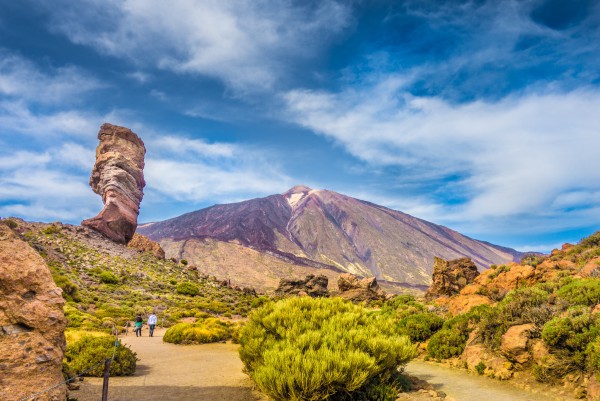El Teide, located in the center of the island of Tenerife, is the third highest volcanic cone in the world, being the most visited national park in Europe and the highest point in Spain with its 3,718 meters.
You can visit the park in multiple ways, accessing it in your own vehicle, bus or through trails that reach from various points of the island.
It is amazing how a lava surface, located at an altitude of over 2,000 meters, is full of plant and animal life.

Juan Évora was the last inhabitant of Las Cañadas who preserved the traditional way of life. The house in which he lived, located at the Boca Tauce crossroads (next to the fork of the TF-21 and TF-38 roads), at the southern access to the Park, has been restored and converted into an information point and small ethnographic museum with an exhibition on the old way of life of the shepherds in Las Cañadas.
This impressive rock formation is a phonolitic volcanic chimney, i.e., a lava vent that ended up solidifying without emerging to the surface, visible by the erosive process.
This impressive rock formation is a phonolitic volcanic chimney, i.e., a lava vent that ended up solidifying without emerging to the surface, visible by the erosive process.
The Teide Cable Car allows you to ascend to an altitude of 3,555 meters, saving a great height difference that would take us about six hours if we wanted to do it on foot.
It reaches the station of La Rambleta, where we can enjoy sensational views of the island of Tenerife and the Canary Islands.
You arrive at the Visitor Center attracted by the beauty of the landscape and you can't even imagine all the natural knowledge about the National Park that you will discover inside. You advance through the center's small museum, devouring the information on the panels and absorbing all about the origin of Teide or the species that inhabit it. You even see with your own eyes the inside of a volcanic tube!
If we catch the afternoon in the park, we should not miss the opportunity to contemplate a sunset next to the Teide and a sea of clouds at his feet.
There are several points from which to enjoy a sea of clouds, as long as the conditions are given. One of the main ones would be the Mirador La Tarta. They can also be enjoyed from the Mirador de Chipeque or the Mirador de las Narices del Teide.
With its 3,718 meters of altitude, climbing to the highest point of Spain is an unforgettable experience where you can contemplate breathtaking views of the Cañadas and, on days of great visibility, see the rest of the islands that make up the Canary Archipelago.
To climb, you can do so via the teleferic, which starts from the base and reaches the summit of the volcano, at about 3.555m high, or you can hike up a 6-hour trail that starts at montaña Blanca.
The Telesforo Bravo trail, which leads to the crater, is restricted by special free permit from the Teide National Park, so remember to apply for it well in advance. With this permit you can sleep in the Altavista refuge to see a beautiful sunrise from the heights.
Please note that climbing to the top requires the use of appropriate footwear and clothing, protection from the sun and monitoring the effects of altitude.